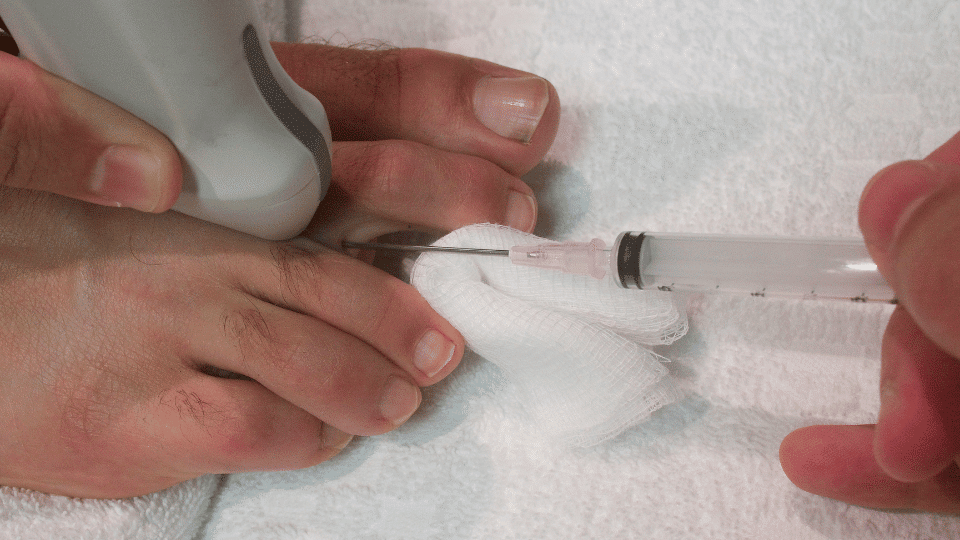
Laser Treatment for Morton's Neuroma In Hicksville, NY
A neuroma is commonly known as a “pinched nerve” or “nerve tumor.” It is a painful condition where the nerve tissue thickens, usually between the toes. The most common type of neuroma is Morton’s Neuroma. It typically affects the area between the third and fourth toes.
Neuromas can be debilitating, causing pain, discomfort, and difficulty walking.
Serving Hicksville, NY, And Nassau County. Fast, Non-Surgical Relief For Morton's Neuroma Pain
Noticing burning, tingling, or numbness between your toes or in the ball of the foot? Our Hicksville, NY, clinic offers fast, non-surgical relief for Morton’s Neuroma with our advanced laser therapy to ease nerve pain, reduce pressure, and restore comfort without surgery, especially if any other traditional treatment hasn’t helped.
Frequently Asked Questions
How Many Laser Therapy Sessions Are Needed For Morton’s Neuroma?
Most patients start noticing relief after 4-6 sessions. A complete treatment procedure plan typically takes 8-12 sessions over several weeks for the best results.
How Soon Can I Feel Relief After Starting Laser Therapy For Morton’s Neuroma?
Many patients notice improvement after a few treatments, while others take time. Full healing will occur over the next weeks as inflammation and nerve irritation decrease.
Is Laser Treatment For Morton’s Neuroma Safe?
Yes, laser therapy is FDA-approved, non-invasive, and safe with minimal risk of side effects.
Are there any side effects from laser therapy for Morton’s Neuroma?
Side effects are rare and typically limited to mild warmth, redness, or slight sensitivity that fades quickly within a few hours
Can laser therapy help avoid surgery for Morton’s Neuroma?
Yes, in many cases, if treated at an early stage, it can reduce nerve inflammation and ease pain enough that surgery isn’t required.
At Restore Podiatry & Laser Center, we are proud to offer our newest, latest laser treatment for Morton’s Neuroma. We take time to understand our patients and understand their needs.
Check Out What Our Client Has To Say
See what our patients are saying. Learn about their experiences and decide if laser treatment for Morton’s Neuroma is the right fit for you.
EXCELLENTTrustindex verifies that the original source of the review is Google. If you are suffering from stubborn plantar wart, I highly recommended Dr. Bhela. He made a stubborn plantar wart that I had for 1 year finally gone after 3 months with SWIFT treatment. I highly recommended SWIFT for plantar wart. The staff was amazing and helpful with scheduling. Overall, I had wonderful experience at Restore Podiatry.Posted onTrustindex verifies that the original source of the review is Google. My experience with Dr Behla was great. Very knowledgeable, took care of my issue in one visit. I went to multiple doctors without any progression. Highly recommend him!Posted onTrustindex verifies that the original source of the review is Google. Dr.Bhela is very professional and detailed at getting results. I Had a great experience at Restore Podiatry and Laser center. Stop spending your money with over the counter ointments that just don’t work. For stubborn nail fungus you need to see a professional to rid yourself of it. Hot laser or cold laser is painless and you will definitely see the results you want spend the money the right way the first time around.Posted onTrustindex verifies that the original source of the review is Google. Dr. David Bhela in Hicksville NY , helped reduce my calluses in less than a month! Super professional, kind, and knowledgeable. Highly recommend!Posted onTrustindex verifies that the original source of the review is Google. Dr. Bhela is a great doctor who is very knowledgeable and helpful. He cares for his patients and you will find that out for yourself if you visit him! He has helped me a lot with my feet and I couldn’t be more thankful. He definitely gets my personal recommendationPosted onTrustindex verifies that the original source of the review is Google. Dr.Davinder Bhela clearly explained treatment options and time frame to expect for visits to treat plantar fascia pain and discomfort. He provided top notch care, very good exercise recommendations for improving muscle tone, plus Dr. Bhela is very kind and friendly. I'm very glad to have worked with him for my care and continued health journey.Posted onTrustindex verifies that the original source of the review is Google. Very good service. Friendly staff and very professional. Highly recommend
Our Service Area For Morton's Neuroma Treatment
We provide FDA-approved laser treatment for Morton’s Neuroma at our Hicksville, NY, clinic. We also serve nearby areas including Woodbury, Huntington, Old Brookville, Plainview, Brentwood, East Hills, Roslyn Heights, Syosset, Westbury, Dix Hills, Glen Cove, Manhasset, Jericho, Levittown, Brookville, Old Westbury, Muttontown, Northport, Roslyn, Greenville, Oyster Bay, and Melville.
Causes of Neuroma
Foot Structure
Individuals with high arches, flat feet, or other structural issues can lead to increased pressure on the forefoot. This can cause nerve irritation.
Choice of Footwear
Tight or high-heeled shoes can squeeze the toes. The increased pressure due to this can affect the nerves between the toes.
Repetitive Stress
Some activities put excessive pressure on the ball of the foot. Running or certain sports that involve high impact can hurt nerves.
Trauma
An injury to the foot or repeated trauma can damage nerves. This can lead to swelling and thickening of nerves.
Symptoms of Neuroma
Patients have often complained of sharp burning pain in the feet. There can be numbness or tingling in the affected toes as well.
Many have complained about the feeling of a lump or the sensation of standing on a pebble while walking. The pain often increases with tight shows or after a weight-bearing activity.
Treatment Options for Neuroma at Restore Podiatry
High Power Laser Therapy
This therapy uses targeted laser energy to reduce inflammation and pain around the affected nerve. It stimulates natural healing through increased blood flow and relieves neuroma symptoms in patients.
Read more about High Power Laser Therapy here.
Deep Tissue Laser Therapy
Deep Tissue Laser Therapy penetrates deep into tissues to reduce pain. This therapy improves circulation and promotes cellular repair and regeneration.
With this therapy, we can help decrease nerve sensitivity and inflammation in the neuroma area. Patients can have quick relief from pain.
Read more about Deep Tissue Laser Therapy here.
Radial Shockwave Therapy
This non-invasive treatment uses high-energy sound waves to stimulate blood flow and promote nerve healing. It effectively reduces pain and discomfort from neuromas.
Read more about Radial Shockwave Therapy here.
Focused Shockwave Therapy
Focused Shockwave Therapy delivers precise energy to the affected area. It is ideal for treating localized pain associated with neuromas.
This non-invasive therapy helps break down scar tissue. It reduces swelling and encourages the body’s natural healing process.
Read more about Focused Shockwave Therapy.
Custom Orthotics
Custom orthotics redistribute pressure across the foot. It helps reduce the pressure on the affected nerve and improves foot alignment.
It is very effective in reducing neuroma-related pain.
Read more about Custom Orthotics here.
At Restore Podiatry & Laser Center, we are proud to offer our newest, latest laser treatment for Morton’s Neuroma. We take time to understand our patients and understand their needs.
